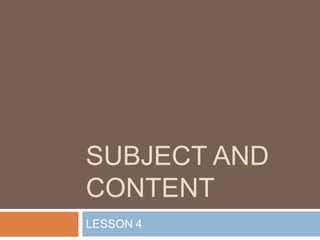
4subjectandcontent-180822021507 (1).pptx
- 2. LEARNING OUTCOMES By the end of this lesson, you should be able to, Differentiate representational art and non- representational art; Discuss the difference between an artwork’s subject and its content; Identify the subject matter and specific examples of art; and Enumerate the sources of the subjects of some of the most recognizable works of art in Philippine art history.
- 3. In viewing art, there are clues that mediate between the artwork and the viewer, allowing the viewer to more easily comprehend what he is seeing. These clues are the three basic components of a work of art: 🞑 Subject – the visual focus or the image that may be extracted from examining the artwork; the “what” 🞑 Content – the meaning that is communicated by the artist or the artwork; the “why” 🞑 Form – the development and configuration of the art work – how the elements and the medium or material are put together; the “how”
- 4. Think-Pair-Share Look at the painting below by artist David Bailly entitled Selbstbildnis mit Vanitassymbolen (Self-Portrait with Vanitas Symbols). List down eveything that you see within the four corners of the work. List as many items as you can in 3 minutes.
- 6. With your seatmate, discuss and compare the items you listed. Based on your answers, write an assumption about what the painting means.
- 7. In the sciences, experimentation is the key to proving a hypothesis or a larger theory. In the arts, there are observable qualities that the artwork holds that will point to its subject, and sometimes even to its content. (look at the constituent figures that are perceptible, the manner in which the
- 9. REPRESENTATIONAL ART These types of art have subjects that refer to objects that refer to objects or events occurring in the real world. Also termed figurative art because the figures depicted are easy to make out and decipher.
- 10. Mona Lisa Leonardo da Vinci (1503)
- 11. Despite not knowing who Mona Lisa is, it is clear that the painting is of a woman that is realistically-proportioned; only the upper torso is shown; a beguiling and mysterious smile is flashed; the background is a landscape
- 12. NON-REPRESENTATIONAL ART Art forms that do not make a reference to the real world, whether it is a person, place, thing, or even a particular event. It is stripped down to visual elements, such as shapes, lines, and colors that are employed to translate a particular feeling, emotion, and even concept.
- 15. Is non-representational art the same with abstract art? There is no clear-cut divide, rather, they exist in a spectrum. Non- representational art Abstract art Representational art
- 16. Head of a Woman, Mougins Pablo Picasso (1962)
- 17. Looking at the combination of lines, shapes, and colors of the sculpture will point to a head of a woman Even with the abstraction of the image, this work is arguably representational art.
- 18. SOURCES AND KINDS OF SUBJECT
- 19. For non-representational art, a higher, level of perceptiveness and insight might be required to fully grasped the feeling, emotion, or concept behind the work. For representational art, it is easier to infer the subject matter because from the figures depicted in the artwork, there is already a suggestion as to its implication.
- 20. Sources of Subject Nature History Greek and Roman mythology Judeo-Christian tradition Sacred oriental texts Other works of art
- 21. Kinds of Subject History Still life Animals Figures Nature Landscape Seascape Cityscape Mythology Myth Dreams Fantasies
- 22. Die Ebene von Auvers (Wheat Fields Near Auvers Vincent van Gogh (1890)
- 23. A Cockchafer, Beetle, Woodlice and Other Insect, with a Sprig of Auricula Jan van Kessel (early 1960s)
- 24. Young Women in the Ricefield Fabian de la Rosa (1902) Fruit Pickers Under the Mango Tree Fernando Amorsolo (1937)
- 25. Discobolus Myron (Roman, 2nd Century AD))
- 27. Shah Jahan Receiving Dara Shikoh Folio from the Late Shah Jahan Album (circa 1650)
- 28. El Tres de Mayo Francisco de Goya (1814)
- 29. CONTENT IN ART
- 30. The meaning or message that is expressed or communicated by the artwork. In understanding the content of art, it is important to note that there are various levels of meaning:
- 31. Factual meaning The most rudimentary level of meaning for it may be extracted from the identifiable or recognizable forms in the artwork and understanding how these elements relate to one another.
- 32. Conventional meaning Pertains to the acknowledged interpretation of the artwork using motifs, signs, and symbols and other cyphers as bases of its meaning. These conventions are established through time, strengthened by recurrent use and wide acceptance by its viewers or audience and scholars who study them.
- 33. Subjective meaning When subjectivities are consulted, a variety of meanings may arise when a particular work of art is read. These meanings stem from the viewer’s or audience’s circumstances that come into play when engaging with art (what we know, what we learned, what we experienced; what values we stand for) Meaning may not be singular, rather, multiple and varied
- 34. Creation of Adam (from the ceiling of the Sistine Chapel) Michelangelo (1814)
- 35. Analysis Subject: biblical art Factual meaning: Creation Story (creation of man) Conventional meaning: man was created in the image and likeness of God Subjective meaning: endowment of intellect to man from God